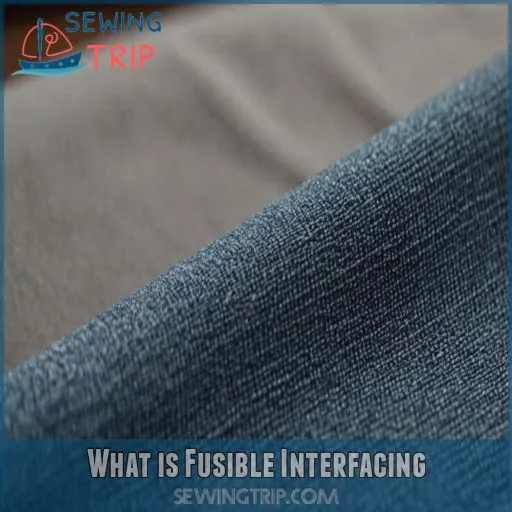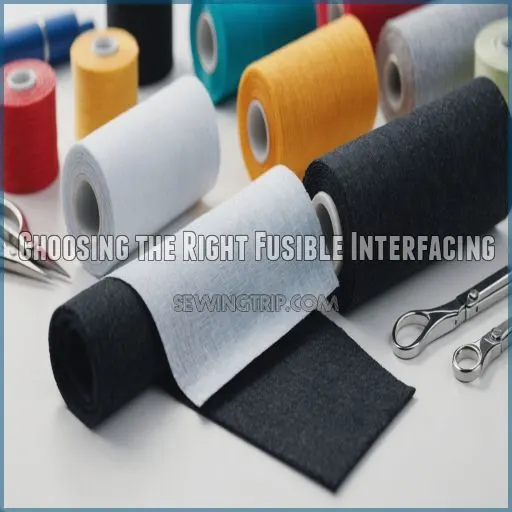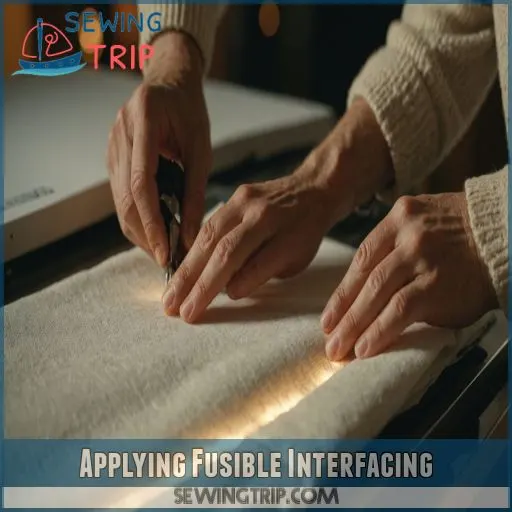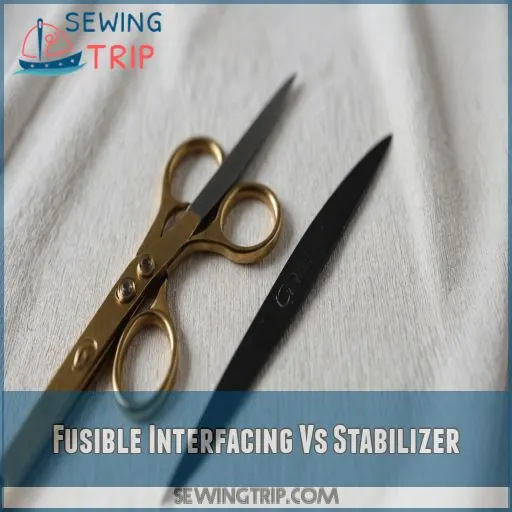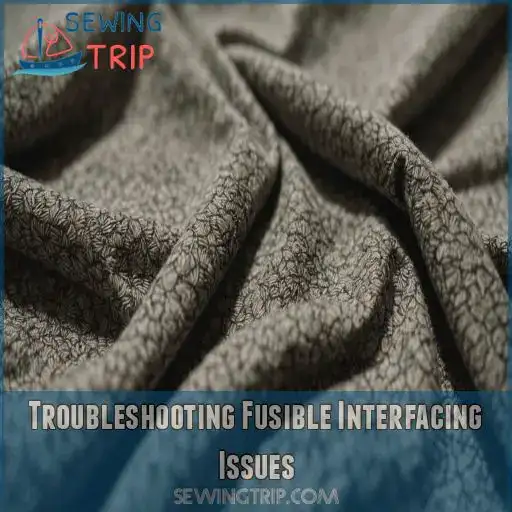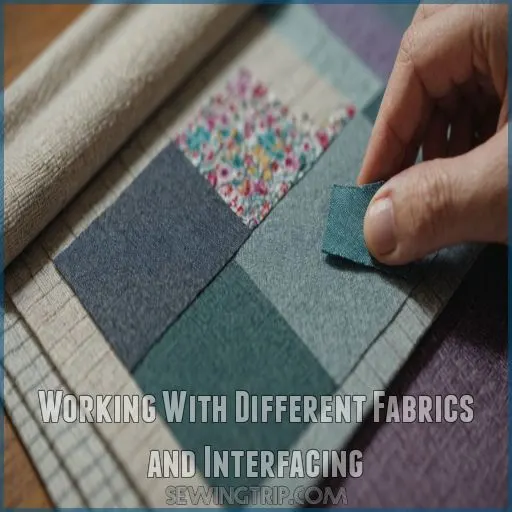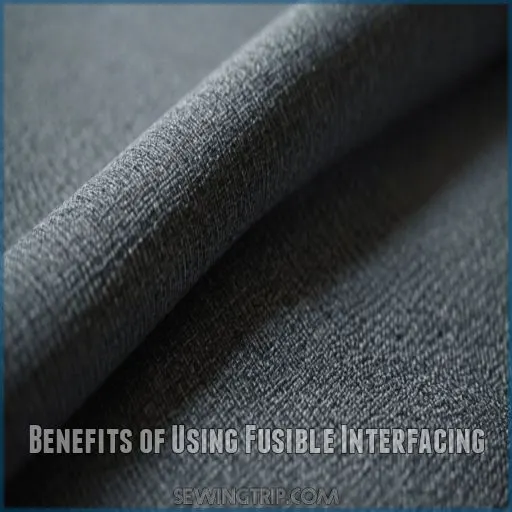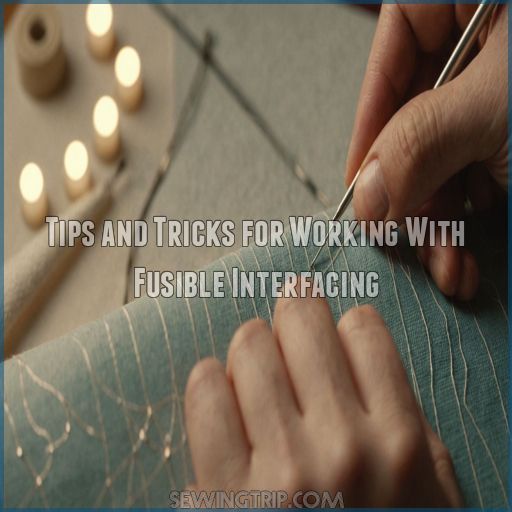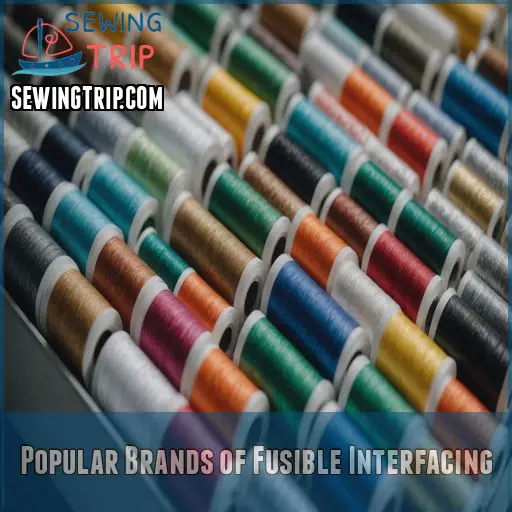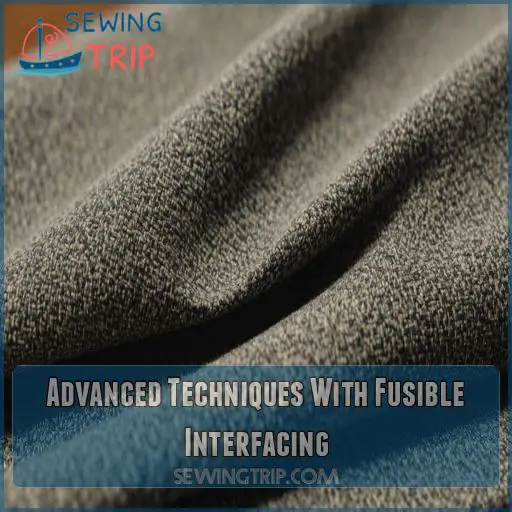This site is supported by our readers. We may earn a commission, at no cost to you, if you purchase through links.
 Curious about fusible interfacing tutorials and how to use it?
Curious about fusible interfacing tutorials and how to use it?
Think of fusible interfacing as your fabric’s best friend—offering support, shape, and a little life coaching!
It’s a heat-activated layer that gives your projects structure.
Imagine this: it’s like adding a backbone to a floppy t-shirt to keep it looking sharp.
Choose from non-woven, woven, or knit, depending on what your fabric’s wearing out for the day.
Simply iron it on with the adhesive side facing the fabric.
Voilà! Just remember, take it easy with the heat, or you’ll end up with a sticky situation.
Stick around for the juicy details!
Table Of Contents
- Key Takeaways
- What is Fusible Interfacing
- Choosing the Right Fusible Interfacing
- Applying Fusible Interfacing
- Fusible Interfacing Vs Stabilizer
- Troubleshooting Fusible Interfacing Issues
- Working With Different Fabrics and Interfacing
- Benefits of Using Fusible Interfacing
- Tips and Tricks for Working With Fusible Interfacing
- Popular Brands of Fusible Interfacing
- Advanced Techniques With Fusible Interfacing
- Frequently Asked Questions (FAQs)
- Conclusion
Key Takeaways
- Think of fusible interfacing as your fabric’s best buddy—it offers extra support and structure, much like a good friend helps you stand tall in tough situations. Just iron it on with the adhesive side against the fabric, and watch it work its magic.
- Choosing the right fusible interfacing is like picking the perfect outfit—it depends on your fabric’s needs. Keep an eye on the fabric type, weight, and stretch, and make sure your interfacing complements these attributes.
- Be mindful when applying fusible interfacing; it’s not unlike making a good sandwich—a damp press cloth and the right temperature setting are crucial. Avoid common mistakes by ensuring the adhesive side is down and the heat is just right.
- Don’t confuse fusible interfacing with stabilizers—they serve different roles. Interfacing adds structure to items like collars, while stabilizers are your go-to for embroidery tasks where fabrics need a steady hand.
What is Fusible Interfacing
Fusible interfacing is your secret weapon in sewing, adding firmness and shape to fabrics with just a touch of heat.
You’ll find it in various types like non-woven, woven, and knit, each ready to tackle a different sewing challenge.
Definition and Purpose of Fusible Interfacing
Fusible interfacing might just become your sewing sidekick! It bonds to fabric with heat and steam, offering:
- Fabric Support: Keeps things firm yet flexible.
- Shape Control: Helps garments maintain their form.
- Structure Enhancement: Adds strength where needed.
Think of it as the secret sauce of seam reinforcement, making everything look polished.
Types of Fusible Interfacing (Non-Woven, Woven, Knit)
When working with interfacing, you’ll discover three primary types: non-woven, woven, and knit.
Non-woven feels like superhero armor, versatile for many fabrics.
Woven mimics your fabric’s grain, perfect for upscale projects.
Knit stretches along with your fabric, like a yoga buddy.
Each has unique properties that suit different sewing adventures.
How to Identify Fusible Interfacing
Identifying fusible interfacing is a breeze! Just look for the telltale texture – it’s smooth on one side and slightly rougher on the other.
The adhesive side is the smooth one, so place that down on your fabric.
Match the interfacing color and weight to your project for best results.
Easy peasy!
Choosing the Right Fusible Interfacing
Picking out the right fusible interfacing feels like matching socks—consider fabric type, weight, stretch, and you won’t end up with a mismatched pair!
Just like you wouldn’t wear swim trunks to a snowstorm, make sure your interfacing’s weight and color align with your fabric for best results.
Factors to Consider (Fabric Type, Weight, Stretch)
When selecting fusible interfacing, think about the fabric type, weight, and stretch.
Stiff fusing isn’t for everything—imagine trying to make a cloud wear a corset!
Consider the project’s needs.
Interface compatibly with the fabric’s texture and drape to avoid creating a stiff, unnatural garment.
Choose wisely, friend!
Matching Interfacing Weight to Fabric Weight
Matching interfacing weight to fabric weight is like picking the right dance partner. You wouldn’t pair a feather with a brick, right?
Use a weight chart or sizing guides for reference.
Fusible interfacing comes in light, medium, and heavy fusing, so choose wisely.
The right pairing transforms your project from blah to wow!
Color Matching and Interfacing Selection
Choosing the right interfacing color is key – you don’t want a stark contrast that distracts from your fabric.
Opt for a hue that blends seamlessly or provides a subtle accent.
Dark interfacing on light fabrics is a no-go, and vice versa.
Play around to find the perfect match!
Applying Fusible Interfacing
Applying fusible interfacing is easier than you think, and it’ll give your projects the support they need to shine.
Just remember, it’s like making a good sandwich—don’t skip heating things up or you’ll miss the magic!
Step-by-Step Guide to Fusing Interfacing
You’ve got your fusible interfacing, now let’s work some magic!
Lay your fabric wrong side up on the ironing board; place the interfacing’s adhesive side on top.
Like buttering toast, cover with a damp press cloth.
Press the iron for 10-15 seconds.
Voilà, you’ve mastered the art of fusing interfacing!
Tips for Successful Fusing (Press Cloth, Adhesive Side)
Ironing fusible interfacing is like making a perfect grilled cheese—requires the right touch! Keep these tips handy:
- Use a pressing cloth to protect fabric.
- Make sure the adhesive side faces the fabric.
- Set the ironing temperature correctly.
- Prep fabric beforehand.
- Troubleshoot issues if needed.
You’re on your way to fabric mastery!
Common Mistakes to Avoid When Fusing Interfacing
Steer clear of placing the fabric’s wrong side up – that’s a rookie mistake!
Dial in the right heat setting and iron pressure to avoid scorching delicate fabrics.
Watch out for adhesive leaks, too – they can really gum up your project.
With a little practice, fusing fusible interfacing will be a breeze.
Fusible Interfacing Vs Stabilizer
Sewing can sometimes feel like deciphering a secret code, especially when you’re sorting out the differences between fusible interfacing and stabilizers.
Let’s clear the confusion and help you decide when to lean on interfacing and when a stabilizer might be your sewing sidekick, ensuring your projects look sharp and professional.
Key Differences Between Fusible Interfacing and Stabilizer
Distinguishing fusible interfacing from a stabilizer is like comparing apples and oranges; each has its unique purpose.
Fusible interfacing adds shape and support to fabric, while stabilizers keep fabrics steady during embroidery.
Texture-wise, interfacing is softer.
When it comes to cost, stabilizers might make your wallet cry more.
When to Use Each in Sewing Projects
In sewing projects, interfacing often takes the spotlight for structure, while stabilizers are the unsung heroes for embroidery or machine stitching. Imagine them as fabric sidekicks that hold everything in place:
- Collars and cuffs: Use interfacing for crispness.
- Hems and pockets: Stabilizers add smoothness.
- Closures: Interfacing stabilizes buttonholes.
- Face masks: Stabilizers offer extra support.
Can Fusible Interfacing Replace Stabilizer?
While fusible interfacing can sometimes replace stabilizer, it’s not a one-size-fits-all solution.
Consider the project, fabric, and desired outcome.
For example, fusible works well for appliqué and face masks, but stabilizer may be better for embroidery.
Use this handy table to choose the right option:
| Criteria | Fusible Interfacing | Stabilizer |
|---|---|---|
| Fabric Type | Most fabrics | Delicate fabrics |
| Stiffness | Moderate | Varying levels |
| Embroidery | Not recommended | Recommended |
| Appliqué | Recommended | Not recommended |
Troubleshooting Fusible Interfacing Issues
Even the best plans can sometimes go awry, leaving you with fusible interfacing that just won’t stick or worse, adhesive leaks that could rival a horror movie.
Don’t worry; this guide will help you tackle these sticky situations with ease, so your sewing projects can shine without any unwanted drama or adhesive antics.
Common Problems With Fusible Interfacing (Not Sticking, Adhesive Leaks)
Let’s chat about common problems with fusible interfacing that can drive you bananas.
If it’s not sticking, the heat settings or fabric type might be the culprits.
Adhesive leaks? That could ruin your day faster than a flat tire.
Mind your iron technique to dodge these sticky situations in tutorials!
Solutions for Troubleshooting Fusible Interfacing Issues
Fusible interfacing not sticking? Check your iron’s heat—too cool, and it’s like trying to melt cheese with a candle!
For adhesive leaks, lay a scrap under your project, catching any rogue stickiness.
Press wrinkles gently with a damp cloth.
Explore fusible interfacing alternatives if all else fails—every pattern piece deserves firm support!
How to Remove Excess Adhesive
If you’ve got pesky adhesive residue left behind after fusing interfacing, don’t fret! Try these handy tips:
- Dab a bit of rubbing alcohol or white vinegar on a clean cloth and gently blot the area.
- Use a fabric shaver or sandpaper to carefully remove any stubborn bits.
- Apply a small amount of dish soap and water, then rinse thoroughly.
- For delicate fabrics, try a specialized adhesive remover product.
- Prevent future issues by always using a press cloth when fusing interfacing.
Working With Different Fabrics and Interfacing
When you’re working with different fabrics, picking the right fusible interfacing can be a real game-changer, turning floppy into fabulous.
Whether it’s delicate, stretchy, or something in between, there’s an interfacing match out there, ready to help your fabric stand tall like a superhero cape!
Using Fusible Interfacing With Delicate Fabrics
When working with fusible interfacing on delicate fabrics, like silk or lace, go easy on the heat. Test a scrap to avoid a meltdown! Here’s a quick guide:
| Delicate Fabric Types | Heat Sensitivity | Interfacing Placement | Stitching Techniques |
|---|---|---|---|
| Silk | High | Light touch | Gentle hand stitching |
| Lace | Moderate | Precise position | Careful machine stitch |
| Organza | High | Minimal pressure | Slow, steady sewing |
| Chiffon | Very High | Delicate touch | Hand or zigzag stitch |
Delicate fabrics require special care when working with fusible interfacing.
Test a scrap of fabric before applying fusible interfacing to the entire piece.
Matching Interfacing to Fabric Type (Knit, Woven, Non-Woven)
Occasionally, fabric types and interfacing match like peanut butter and jelly, enhancing your project.
Knit interfacing suits stretch fabrics perfectly, giving them flexibility.
Woven interfacing is great for structured projects, while non-woven types play well with most fabrics.
Choose interfacing weight wisely—light for drapey fabrics, heavy for sturdy ones.
Your sewing bliss awaits!
Tips for Working With Stretchy Fabrics and Interfacing
When working with stretchy knits, opt for a fusible knit interfacing.
It flexes and moves with the fabric, preventing distortion.
Apply it carefully, using a press cloth to avoid scorching the delicate fibers.
With a little practice, you’ll be sewing stretchy projects like a pro!
Benefits of Using Fusible Interfacing
You’ll love fusible interfacing because it’s a time-saver and so easy to use, especially when you’re in a hurry to finish that stubborn sewing project.
It can magically transform quilts, bags, and garments with its structural wizardry, making your creations look fabulous and feel professionally crafted.
Advantages of Fusible Interfacing (Time-Saving, Easy to Use)
Using fusible interfacing can feel like discovering a secret sewing shortcut. It’s a time-saving, easy-to-use tool that offers neat results without the headaches.
Forget sewing in extra layers—just fuse away!
You’ll be amazed at how versatile this handy helper is, making your projects more enjoyable and less frustrating.
How Fusible Interfacing Can Improve Sewing Projects
You know that feeling when your shirt collar just can’t stay put? Fusible interfacing is your knight in shining armor! It provides fabric stability, giving your garment structure that lasts.
Whether it’s collar shaping or adding buttonhole support, fusible interfacing is the secret ingredient for bag making and beyond.
Popular Uses for Fusible Interfacing (Quilting, Bag-Making, Garment Construction)
Quilting, bag-making, and garment construction are just a few of the many creative applications where fusible interfacing shines.
Elevate your sewing projects with its versatile support, adding structure, stability, and a professional finish.
Experiment and let your imagination soar – the possibilities are endless!
Tips and Tricks for Working With Fusible Interfacing
Feeling overwhelmed by fusible interfacing? Don’t worry, I’ve got you covered with some quick tips that’ll have you fusing like a pro in no time—just remember, ironing isn’t about pressing your luck, so keep that heat in check!
Fusing like a pro is easy with these tips!
Pre-Washing Fusible Interfacing for Better Results
Ready to rock your sewing projects with fusible interfacing? Let’s sprinkle a dash of wisdom about pre-washing it.
Doing so reduces shrinkage and wrinkles, matching fabric type like magic before ironing.
Best practices? Treat it like a finicky cat—gentle wash, air dry.
Watch it blend with fabric flawlessly!
Sewing Through Fusible Interfacing (Tips and Techniques)
As you sew through fusible interfacing, set your sewing machine stitch length slightly longer than usual to avoid puckering.
Imagine your needle dancing gracefully across the fabric.
Pay extra attention to interfacing placement, ensuring everything aligns.
Try using a ballpoint needle for knit fabrics and explore project examples like crafting sturdy collars!
How to Remove Fusible Interfacing From Fabric
Removing that pesky fusible interfacing can be a real headache, but don’t worry – we’ve got your back!
Start by carefully seam-ripping the area, then use a steam iron to gently lift the adhesive.
Avoid excessive heat to prevent fabric damage.
With a little patience, you’ll have that interfacing off in no time!
Popular Brands of Fusible Interfacing
When you’re picking fusible interfacing, knowing your brands is like having a map to a treasure trove of crafting possibilities.
From ultra-smooth finishes for silk to interfacing that’s tougher than a Monday morning for leather, there’s definitely a brand for whatever wild sewing adventure you’ve planned.
Overview of Popular Brands and Their Features
You’ve got your interfacing tips up your sleeve; now let’s chat about popular fusible interfacing brands! Pellon is a household name with diverse options, while Vilene offers reliable interfacing worldwide. HeatnBond boasts a strong reputation for craft projects. These brands bring unique features, ensuring you’ve got the right interfacing for every fabric challenge.
Comparison of Different Brands and Their Uses
Choosing fusible interfacing can feel like going through a maze.
Among the options:
- Pellon offers great quality and durability at a middle-of-the-road price.
- Bosal is known for its excellent application ease.
- Vilene combines affordability and reliability.
- Clover, though pricier, delivers unmatched softness.
Don’t break the bank—pick what fits your project’s needs!
Specialty Interfacing for Specific Projects (Silk, Leather)
When sewing with delicate fabrics like silk or leather, reach for specialty fusible interfacings made for their unique needs.
Silk calls for a lightweight, soft option, while leather demands a sturdy, reinforcing interfacing.
Explore the options in the table below to find the perfect match for your project.
| Fabric | Recommended Interfacing |
|---|---|
| Silk | Silk organza, silk chiffon |
| Leather | Woven, non-woven, knit |
| Suede | Microsuede, woven |
| Lace | Lightweight, non-woven |
Advanced Techniques With Fusible Interfacing
Ready to up your sewing game with fusible interfacing?
You’ll explore creative ways to add dimension and stability to quilting,
make custom interfacing for those one-of-a-kind projects,
and play around with different weights and types just like trying on new shoes—sometimes you’ll find the perfect fit!
Using Fusible Interfacing in Quilting and Patchwork
When you’re tackling quilting and patchwork, fusible interfacing can help stabilize quilt blocks perfectly.
Consider the type and weight of interfacing to match your fabric. It’s like giving your project an iron backbone!
For patchwork applique, use a lightweight interfacing to keep it supple yet steady, without losing that cozy charm.
Creating Custom Interfacing for Unique Projects
Let’s create custom interfacing blends for those unique projects!
Imagine this: you’re crafting a bag with unique textures that no store-bought option can satisfy.
That’s when DIY interfacing enters, allowing you to tailor the perfect custom shape.
Mix fabric scraps for project-specific blends that’ll spruce up your work like nobody’s business!
Experimenting With Different Interfacing Weights and Types
Experiment with different interfacing weights and types to discover new sewing possibilities.
Pair lightweight interfacing with delicate fabrics, while heavy-duty options reinforce structured projects.
Blend interfacings to create custom mixes that meet your unique needs.
The options are endless – get creative and see what works best!
Frequently Asked Questions (FAQs)
What is a fusible interfacing?
Think of fusible interfacing as a superhero cape for your fabric, adding strength and structure.
You simply heat it up with an iron, and it bonds to your fabric, offering it the firmness it craves.
What can I use instead of fusible interfacing fabric?
If you don’t have fusible interfacing, try using a sew-in version instead.
It may take a bit more work, but it’ll give your fabric the same structure and support without the heat-activated adhesive.
You’ve got this!
What is the main purpose of interfacing?
Providing polish and support, interfacing magically makes your fabric firm, adds shape, and supports sensational structure.
It’s like a secret superhero for sewing, subtly ensuring everything stays smooth, snappy, and smart without stealing the spotlight!
Is fusible interfacing the same as stabilizer?
Fusible interfacing and stabilizers aren’t the same but share similarities.
Interfacing adds structure to fabrics, while stabilizers, mainly in embroidery, prevent stretching and distortion.
Both boost fabric performance, but with distinct roles in crafting.
How to remove fusible interfacing from fabric?
Think of fusible interfacing like a stubborn sticker.
Remove it by applying a damp cloth, then iron on low heat to loosen the bond.
Peel it gently but firmly, repeating if needed.
Patience pays off here!
Can fusible interfacing be dyed to match fabric?
Fusible interfacing can absolutely be dyed to match your fabric.
Just grab some fabric dye, follow the instructions, and voila – a perfectly coordinated look.
It’s an easy way to get that custom touch.
Does fusible interfacing affect fabrics breathability?
Imagine breathing through a straw—fusible interfacing, though great for stability, can reduce fabric breathability by creating a barrier against airflow.
It’s like putting a raincoat on your fabric; stylish, but not exactly airy (Source).
Is fusible interfacing environmentally friendly?
Fusible interfacing’s eco-friendliness hinges on its materials.
Opt for brands using biodegradable or recycled components.
Though not inherently green, you can mitigate impacts by choosing wisely, much like selecting a ripe avocado in a bustling market.
Can fusible interfacing be used for upholstery projects?
Fusible interfacing for upholstery? It’s like using a feather to stuff a mattress!
While it’s great for clothing, it usually can’t handle the heavyweight demands of upholstery.
Opt for stronger, sew-in interfacing for long-lasting results.
Conclusion
Ultimately, fusible interfacing is a sewing superstar—it’s the unsung hero that elevates your projects from limp to lively.
Whether you’re a seasoned sewist or just starting out, mastering the art of fusible interfacing will take your creations to new heights.
So get started, experiment, and watch your fabrics transform into structured, professional-looking masterpieces. With these tutorials, you’ll be a fusible interfacing pro in no time!

